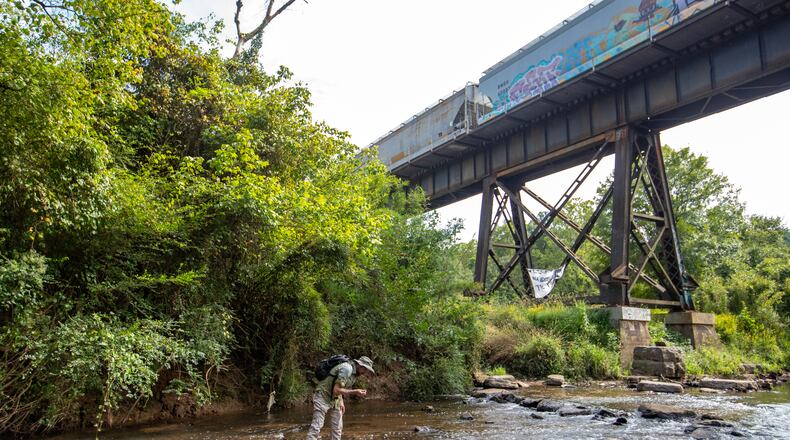Joe Peery was pushing his way through a particularly dense area in the South River Forest one day in 2014 when he stumbled upon what he first thought was a graveyard.
The east Atlanta resident discovered the wooded haven just outside of the city when searching for mountain bike trails and a place to hike with his dog. He’d often find weird things out there — sometimes cars riddled with bullet holes or in another case an abandoned Wurlitzer organ.
But the 8-foot-long structures, with the names ‘Poe,’ ‘Homer’ and ‘Virgil’ carved meticulously into their faces, looked to him like the remnants of another time.
“There were all these huge marble stones that were just sticking up out of the ground that were really elaborate and beautiful,” he recalled.
Known as the Carnegie stones, the marble blocks were actually the remains of Atlanta’s first library that was built at the corner of Church Street (now Carnegie Way) and Forsyth Streets in 1902.
After being demolished in 1977, stones with the names of famous authors that once were displayed proudly on the facade of the building were dumped in the South River Forest.
Peery joined an effort to rescue the stones, but he said the historical slabs were caught in limbo between DeKalb County, where the land resides, and the city of Atlanta, which owns the land.
Today, the land in the South River Forest is at the center of a heated debate over Atlanta’s plans to build an 85-acre public safety training facility, which the city argues is imperative to properly train and recruit police officers and firefighters.
Tensions have been heightened by the recent indictment of more than 60 training center opponents under the state’s Racketeer Influenced and Corrupt Organizations Act. On Thursday, police arrested five people who chained themselves to construction equipment.
Many of the opponents cite environmental concerns or fear of increased policing as an argument against the project. The growing opposition has sparked an effort to put the training center on the ballot through a referendum vote.
A small group of people is worried about something much different: the potential loss of history.
“We know the area that’s been cleared (for the project) includes the area where the Carnegie stones were, so I have no idea what’s happened to them,” Peery said.
Credit: Library of Congress
Credit: Library of Congress
The uncertain fate of the Carnegie stones isn’t the only concern for local history buffs and residents who had been exploring the land long before the city of Atlanta OK’d plans to build the facility.
The massive property has lived many lives and played host to some of the most brutal chapters of Atlanta’s history. First inhabited by Muscogee people, the area was also several plantations, saw troop movement during the Civil War and was eventually operated by the city as a prison farm.
Apart from trash dumped there over the years, residents who explored the area may have come across things like the remains of the prison buildings or traversed over the graves of multiple zoo animals — both Coca and Maude the elephants and gorilla Willie B.
But up until the controversial project made headlines, much about the land was a mystery. Only small handfuls of local enthusiasts and hikers spent time exploring under the canopy of one of the region’s biggest urban forests.
A team of historians from the Atlanta History Center recently spent time compiling all they could about the history of the 85 acres which seems destined to hold Atlanta’s massive public safety facility. The organization was asked by the mayor’s office to find out what they could about the site for as far back as history would allow. This story relies heavily on those findings.
The task wasn’t easy for a number of reasons. Previous historians and newspaper reports over the years had mistakenly conflated the prison farm site with a federal prison farm — known as the honor farm — that operated nearby. The DeKalb County Courthouse, which housed decades of property records, also mysteriously burned down in 1842.
The city-run prison farm morphed quickly from its early uses — originally purchased to be a crematorium, it turned into a dairy farm and then to the prison — so it was referred to by many different names.
“We knew that we not only were starting from scratch, we were starting from misinformation,” said Claire Haley, vice president of special projects at the center. “So correcting that was a challenge.
We’re glad that people are interested in that history because I think whatever resolution you come to about all these issues, it will only be made more complete by understanding that history.”
Early inhabitants and the mark they left
Historians who have tracked the history of land parcels 82 and 83 — the site of the training center in unincorporated DeKalb — go much further back than the prison farm era and the Civil War.
Less than two miles away from the site of the training facility, archeologists found the earliest signs of an Atlanta-area civilization that existed during the late Archaic and early Woodland periods, from 3,000 BCE to 0 CE, known today as Soapstone Ridge, a historic district in DeKalb County.
Historians believe that there could be a link between the historic site and the training center property.
Hundreds of years later, the Muscogee people lived on the land. The Native American tribe was once called by historian Alan Gallay “the most powerful Indian nation on the southern frontier.”
Some descendants of the Muscogee people have joined opponents of the training center to save what they call the Weelaunee Forest, known today as the South River Forest.
In the early 1800s the U.S. government pressured the Muscogee people into millions of acres of land cessions. In 1821, during the Treaty of Indian Springs, present-day Atlanta was sold off to white settlers in a land lottery.
Local archeologist Casey Sharp said he’s spent time researching all the previously recorded archeological finds within one mile of the proposed training center site.
“I can guarantee you that Native American sites are being run over there as we speak,” Sharp said.
While construction crews might not come across mass burials or mounds, they’ll likely come across things like pottery and arrowheads, he said.
“Disturbing a little bit of stuff like that during construction is not the biggest deal,” Sharp said. “But you’re supposed to take steps to mitigate that from happening as much as possible.”
As part of the project process, the Atlanta Police Foundation commissioned an archeological survey of the proposed area, conducted by a company called Terracon.
The first version of their report was presented to the project’s Community Stakeholder Advisory Committee and raised eyebrows when much of the historical background on the site was inaccurate. The company also did not fulfill the requirement to conduct interviews with area experts. The committee requested Terracon correct factual errors and issue an amended report.
Sharp, who conducts the same surveys for his job, said that a revised report that followed, to him, looks like the company simply made a cursory check of the area to sign off on the project.
Just a mile or so away from the training center site on a Friday afternoon, a ragtag group of local history buffs including Sharp and Peery waded through a shins-deep area of the South River.
“You don’t need a hugely trained eye to find stuff,” Sharp said. On that day, the group easily stumbled across pieces of worked quartz — with markings indicating they were fashioned into tools — and pieces of chert that was commonly traded between Native American tribes.
Terracon didn’t list a single archeological find. If it had, it wouldn’t have stopped construction but would have triggered a higher level of archaeological monitoring.
“Testing resulted in no cultural materials identified from the subsurface or surface,” Terracon concluded, although surveyors recommended mitigation efforts to protect prison farm buildings that fall under criteria for historic classification.
A faction of training center opponents is worried about potential unmarked graves from the plantation era through years of inhumane conditions at the prison farm — although no evidence has been found to support the theory.
“Considering the history of that land,” Sharp said, “the possibility of there being unmarked graves in that area is unbelievably high.”
Credit: Arvin Temkar
Credit: Arvin Temkar
Ghosts of the old prison farm
Nearly six decades ago, Atlanta Constitution reporter Dick Herbert hatched a plan to get himself arrested.
In 1965, almost all of the inmates at the Atlanta prison farm on Key Road in the southeast side of the city were there for drunken behavior in public or traffic violations for an average stay of around 15 days.
While they were there, they were assigned activities like harvesting vegetables from okra to collard greens, tending to the city’s livestock or plowing tractors across the grounds.
Herbert, by this own choice, was one of them.
The undercover journalist sought to expose the brutal reality of life inside the stone walls. His reporting spotlighted the prison’s hostile ecosystem including a rampant prescription pill trade, a rigid class structure created by inmates and long days spent chopping away at kudzu vines with a scythe that left blisters on their hands.
Credit: Mandi Albright
Credit: Mandi Albright
Historians hail his series of seven articles as one of the only first-person accounts of how inmates led their lives on the roughly 300-acre property.
Newspaper reports throughout the years since Atlanta began operating the prison farm in 1925 detail severe overcrowding, lack of access to medical care, limited air-conditioning and mass disease — most notably an influenza outbreak in 1957. One news article on the prison farm mentioned a rampant infestation of lice.
One Atlanta Constitution article from May 1976 references the graves of 280 inmates on the prison farm site but doesn’t go into further detail.
At the prison farm, if an inmate was caught breaking the rules in 1976, they’d be sent to what correctional officers referred to as “motivational therapy rooms,” according to Atlanta Constitution articles, more commonly known as solitary confinement.
Until the site was recently closed to the public by Atlanta and the surrounding parks by DeKalb County officials, visitors could go stand inside what remained of the solitary confinement cells.
“There’s something about standing in a place,” said Haley with the history center. “We love history, we love reading about history, but there’s something about seeing it too that can really help people understand what we’re talking about.”
Atlanta Mayor Andre Dickens’ hand-picked training center task force recommended ways to memorialize the cruel history of the prison farm and suggested renovating current buildings for exhibits — but the dilapidated nature of the structures may create challenges.
Credit: Jenni Girtman
Credit: Jenni Girtman
Unsolved mysteries
Despite historians’ best efforts to nail down the site’s history decade after decade, there are still many unknowns.
The fire that engulfed the DeKalb County Courthouse one January night in 1842 took with it tax digests and deeds that were crucial to the puzzle of who owned and lived on the land after it was taken from Native peoples.
The blaze was attributed in news coverage at the time to the “carelessness of some card players at a late hour in the night, in one of the vacant rooms.”
What we do know is that two plantations operated on the property. From 1848 to 1850, William Morris owned the land and 12 enslaved people. Then it was sold to George P. Key — of Key Road — who farmed the land and owned up to 19 enslaved people which made it one of the largest slave plantations in DeKalb County.
There are two prominent and surprising gaps in knowledge: the time between the Civil War and the city’s purchase; and the very recent history of what was happening on the land after the prison farm closed.
“After that it is a bit murky,” Haley said. “There is some police training activity happening around there. Then it just seems like it kind of sat there for a long time and a lot of it was vacant.”
News coverage in the early 2000s started to identify the property as a potential park site. A lengthy report released in 2017 by the Department of City Planning called utilizing more than 1,200 acres of land in the South River Forest a “last chance for a massive urban park.”
That included the 300 or so acres of Atlanta-owned property home to the old prison farm.
TIMELINE: More about the old prison farm
About the Author
Keep Reading
The Latest
Featured









